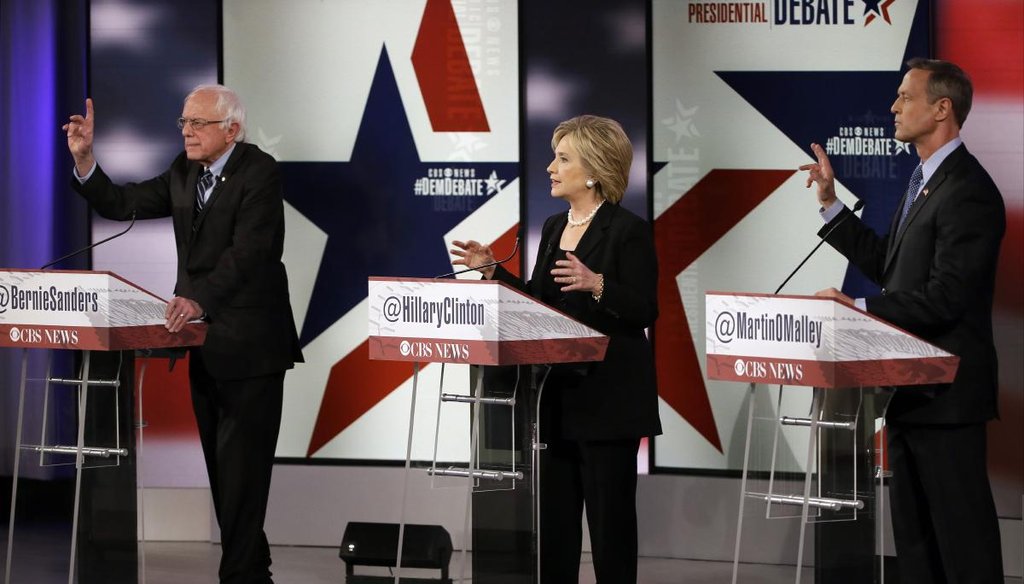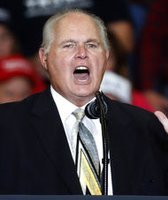Stand up for the facts!
Our only agenda is to publish the truth so you can be an informed participant in democracy.
We need your help.
I would like to contribute

Bernie Sanders, Hillary Clinton and Martin O'Malley debate Nov. 14, 2015, in Iowa. (AP)
The deadly attacks in Paris shifted the focus of Saturday's Democratic presidential debate to foreign policy and the United States' responsibility to help destroy ISIS.
PolitiFact examined several claim from the Des Moines, Iowa, debate.
Talking about what the United States should do to stop terrorism, Sen. Bernie Sanders, I-Vt., said, "We're spending over $600 billion a year on the military. And yet significantly less than 10 percent of that money is used to fight international terrorism."
That rates Mostly False
The Sanders campaign told us that he was talking specifically about the budget to fight the ISIS, which is about $5.3 billion.
But the fight against international terrorism is broader than that. The Defense Department includes its operations in Afghanistan as part of the fight against terrorism. And in 2015, the Pentagon said it will spent about $60 billion combatting terrorism.
That’s nearly 11 percent of the entire military budget, and does not include billions of more dollars being spent by the FBI and CIA.
Sanders on troops returning home
Sanders also stressed that he think countries in the Middle East need to do more to combat ISIS and other terrorist elements. The United States has already paid a high price, he said.
"When you talk about the long-term consequences of war, let's talk about the men and women who came home from war," Sanders said. "The 500,000 who came home with PTSD and traumatic brain injury. And I would hope that in the midst of all of this discussion this country makes certain that we do not turn our backs on the men and women who put their lives on the line to defend us."
The claim that 500,000 troops came home from Iraq and Afghanistan with PTSD and traumatic brain injury rates Mostly True.
The U.S Department of Veterans Affairs estimates that between 11 and 20 percent of veterans from Operation Iraqi Freedom and Operation Enduring Freedom (Afghanistan) have PTSD in a given year. As of late 2014, about 2.7 million troops had served in Iraq or Afghanistan. That’s translates to a pretty wide range of between 297,000 and 540,000 troops.
Those figures only account for PTSD, not traumatic brain injury, or TBI, which Sanders also referenced.
A 2013 Congressional Research Service paper on traumatic brain injury found that almost 57,000 Operation Enduring Freedom and Operation Iraqi Freedom veterans were evaluated or treated for "a condition possibly related to TBI" by the VA.
That number is slippery though. It’s not clear that all of those nearly 57,000 actually received a TBI diagnosis, and it doesn’t account for the potentially thousands more veterans who experienced a traumatic brain injury but did not receive care through the VA.
O'Malley asks for a fact-check; we deliver
Former Maryland Gov. Martin O'Malley begged to be fact-checked when discussion turned to immigration.
"Let’s say it in our debate because you’ll never hear this from that immigrant-bashing carnival barker Donald Trump: The truth of the matter is net immigration from Mexico last year was zero. Fact-check me. Go ahead, check it out," O’Malley said.
We were up for the challenge and found O'Malley's claim to be Mostly True.
There is no perfect way to measure "net migration," but experts typically rely on data from the U.S. Census Bureau tracking the number of people living in the United States who were born in Mexico.
That data shows that the number Mexican-born Americans dropped each year from 2010 to 2013. And while it did increase in 2014, it remains well below the peak in 2007.
"O'Malley was mostly correct," said Alex Nowrasteh, an immigration policy analyst at the libertarian Cato Institute. "The population increased but it was small. Mexican immigration certainly isn't surging anymore."
The margin of error is large enough that the actual number of Mexican-born people living in America in 2014 could be lower than it was in 2013.
Why is migration from Mexico to the United States slowing down?
Demographics is possibly the biggest driver. The birth rate in Mexico has fallen steadily since at least 1990 and now stands at 2.2 children per woman. Marc Rosenblum at the Migration Policy Institute said that translates into fewer people coming into the workforce.
Rosenblum told us that apprehensions at the border strongly suggest that fewer people are trying to sneak into the country. Data from the U.S. Border Patrol show a drop of more than 50 percent since 2009. It used to be border agents stopped over half a million people coming in from Mexico. Last year, it was about 230,000.
More surveillance, stiffer penalties and more barriers at the border have had the intended effect, he said.
Other drivers include the hit on the construction industry during the recession. That was a sector that drew many immigrants, and while it has recovered a bit, it is not nearly as robust as it once was.
Plus, according to one survey, Mexicans who return to their native country generally find that they make more money than when they left.
Clinton on wages
As talk turned to the economy, former Secretary of State Hillary Clinton was asked about how she would pay for such proposals as paid family leave. Clinton said she would not raise taxes on the middle class.
"I have made very clear that hard-working, middle-class families need a raise, not a tax increase," she said, adding that "wages adjusted for inflation haven’t risen since the turn of the last century."
That's Half True.
To check her assertion about stagnant wages, we turned to figures collected by the Bureau of Labor Statistics.
We looked at figures for the third quarter of 2015. And to design the fairest comparison, we looked at third-quarter data for two different years -- 1999 and 2000 -- that could be used to describe the baseline "since the turn of the last century."
The data show that wages did rise between 1999-2000 and 2015, though not very much. Median weekly earnings of full-time wage and salary workers increased between 6 and 8 percent depending on your starting point.
That's a rise, albeit not a huge one, as Clinton spokesman Nick Merrill pointed out when PolitiFact contacted the campaign.
Sanders on taxes
When asked, Sanders wouldn’t reveal just how high he’d raise income taxes on the rich during the Iowa presidential debate, but he guaranteed it wouldn’t be as much as it has been in the past.
"We haven’t come up with an exact number yet, but it will not be as high as the number under Dwight D. Eisenhower, which was 90 percent," Sanders answered.
Sanders is talking about the tax rate that’s applied to the last dollar earned. The U.S. tax system is based on brackets. The top marginal tax rate applies to the highest bracket. Income is taxed at higher rates as more is earned.
During the eight years of the Eisenhower presidency, from 1953 to 1961, the top marginal rate was 91 percent. (It was 92 percent the year he came into office.)
What does it mean, though? For the duration of Eisenhower’s presidency, that rate affected individuals making $200,000 or more per year or couples making $400,000 and above per year.
In 2015 dollars, that's roughly $1.7 million for an individual and $3.4 million for a couple.
Today the tax brackets are adjusted for inflation, but are exceptionally lower than in Eisenhower’s day. The top rate in 2015 is 39.6 percent, applied to single people making $413,200 or more per year, or married couples filing jointly making $464,850 or more annually.
We rated Sanders' statement that income tax rates under Eisenhower were as high as 90 percent True.
Sanders on health care
Sanders also repeated one of his go-to talking points: He said the United States is "the only major country on earth that doesn't guarantee health care to all people as a right, not a privilege."
Among the wealthy Organization for Economic Cooperation member nations, America -- with the possible exception of Mexico -- stands out as the only one that lacks universal health coverage.
The question of a guaranteed right to health care is murkier. Sanders spoke as though every advanced economy has it. In reality, some do and some don’t.
Nearly every European nation has signed and ratified the European Social Charter. That treaty’s section on health care casts coverage as a right.
But Australia and Japan, like Europe, has universal coverage, but they operate under no legal claim that health care is a guaranteed right. Other countries have signed on to international treaties that speak of the obligation of countries to provide for the health of their residents. But it varies by country whether those treaties have teeth.
We rated Sanders' claim Half True.
Our Sources
Linked in story.





















































